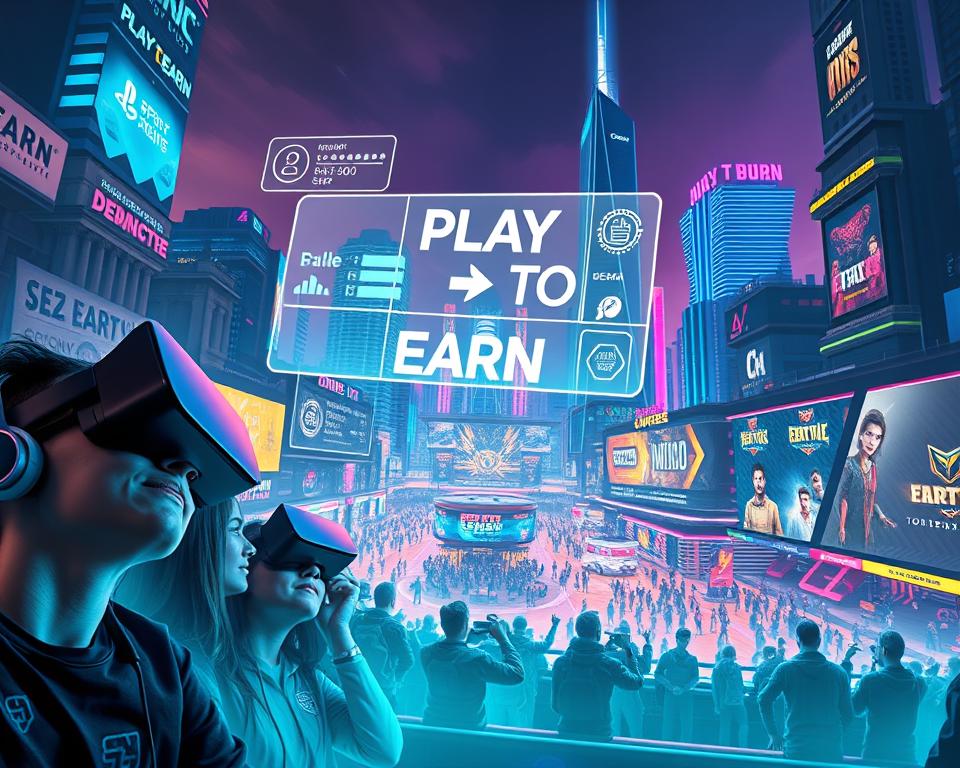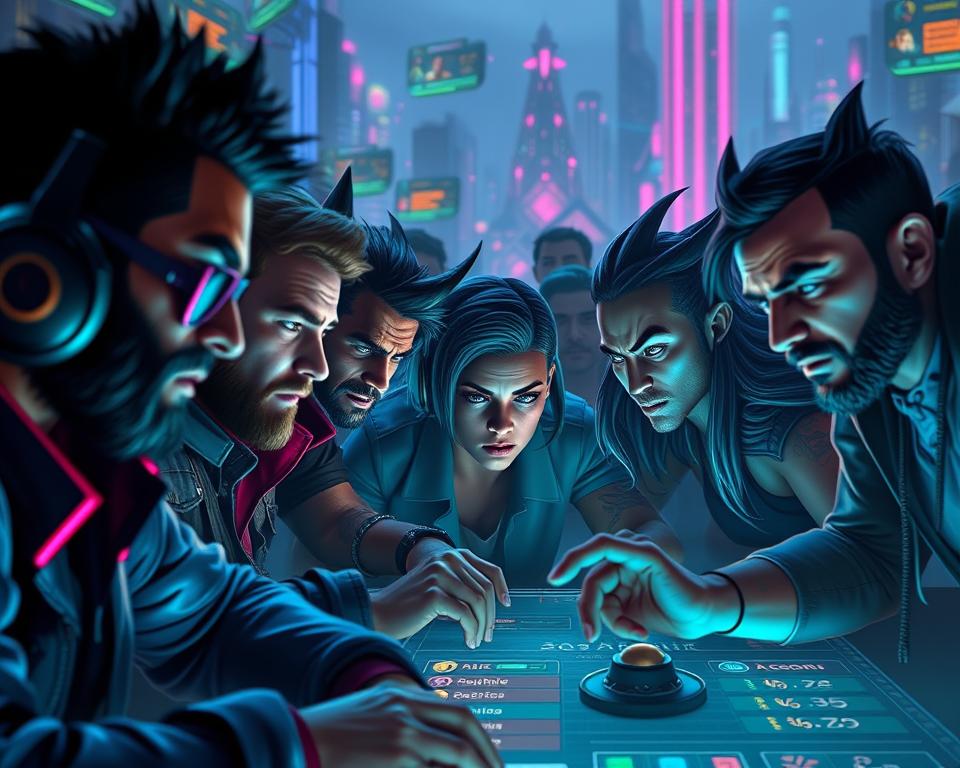Anúncios
Did the first wave of token rewards really fix how you play, own, and earn in games—or did it teach designers what to change?
This short introduction sets the scene for an ultimate guide to how the gaming industry shifted after 2021. Back then, total value locked in p2e shot from about $260 million to over $3 billion. Big titles like Axie Infinity and The Sandbox proved NFT economies could work, but they also revealed limits.
Since that surge, the industry moved toward steadier designs and gameplay-first thinking. Entry barriers eased as teams focused on onboarding, governance, and fair rewards. That matters for you in the real world of blockchain-enabled games.
In the sections ahead you’ll get clear, practical insights: how modern systems work, which games to watch, where risks sit, and what signals suggest long-term viability. Expect concise, useful analysis to help you evaluate options in today’s evolving games ecosystem.
Introduction to 2025’s Play2Earn guide
Play2Earn guide: 2025 favors stable systems over fast token runs.
The boom you remember peaked in 2021. Total value locked shot past $3 billion and Axie Infinity reached more than 2.5 million daily players.
That rapid rise exposed problems. High entry costs and speculative cycles forced designers to rethink how rewards work. Modern p2e games now add caps, token sinks, and governance to protect value.
For you as a player, this shift means smoother onboarding and clearer wallet flows. Game teams focus on lowering barriers with rentals, trials, and simpler starter packs.
What to expect: rewards and potential still exist. But they come with trade-offs and real risks. You should research projects and treat opportunities with caution.
- Why it matters: gameplay and stability now shape long-term value.
- How it changed: token design favors caps and sinks over unchecked emissions.
- Your next step: learn everything need know and what you need know before you play2 or earn in this evolving world.
What changed since the first P2E wave
After the 2021 rush, design shifted from frantic token drops to steady systems that last.
From explosive growth to measured, sustainable design
Many projects learned the hard way that unchecked token emissions erode value fast. Teams now use variable rewards, token burns, and revenue-sharing to slow inflation and protect economies.
Shift from speculation to utility and gameplay-first approaches
Games tie tokens and nft utilities to real in-game actions like crafting, progression, and events. That changes the loop: rewards support long-term engagement instead of encouraging quick flips.
Lower barriers to entry and better onboarding
Early “pay-any-price-to-start” models gave way to new ways to join. Lending, rentals, scholarships, and free trials cut upfront costs in titles such as Axie Infinity.
Onboarding improved too. Simpler wallets, custodial options, and clearer tutorials help new players spend less time on setup and more time enjoying the game.
- One first takeaway: sustainable pacing beats explosive growth.
- Practical result: developers test tokens and seasons, iterating on drops and events based on community feedback.
For a deeper look at lessons from scale, see this analysis of Axie Infinity.
How the P2E model works in 2025
Modern designs focus on steady incentives, clear ownership, and real economic loops you can follow.
In-game assets as NFTs and what “ownership” really means
Many in-game assets live on a blockchain as nft items. You can hold them in a wallet, trade them, or use them across games that support the same standards.
Ownership means verifiable control of an asset on-chain, but practical rights depend on each game’s smart contracts and terms.
Token rewards, marketplaces, and economic loops
Tokens power progression and rewards. You earn by playing, then choose to spend, stake, craft, or list items on a marketplace.
Good designs balance sources and sinks—crafting, upgrades, or limited mints—to keep supply useful over time.
Governance, revenue sharing, and alignment of incentives
Governance gives token holders a voice on fees, emissions, or feature proposals. Revenue sharing can link developers players so growth benefits the community.
Funding rewards: ad revenue, fees, and ecosystem treasuries
Rewards are funded in different ways: marketplace fees, ecosystem treasuries, and sometimes ad revenue help pay out without relying only on new users.
Tip: check docs, audits, and published treasury policies to see how emissions and reserves are managed day to day.
Market snapshot and notable games to watch
Here’s a concise market snapshot highlighting notable titles shaping how economies and gameplay connect today.
Axie Infinity: lessons from peak scale and tokenomics
axie infinity scaled to more than 2.5 million daily active players in 2021. That growth exposed stress points in its reward model.
Early rewards used SLP for play and AXS for governance. Entry costs of $200–$400 for a starter team pushed many into scholarships.
Lesson: balancing emissions, breeding costs, and sinks matters to hold long-term value.
The Sandbox: creation, SAND utility, and LAND demand
The Sandbox tied creator tools to a broader metaverse economy. By November 2021 it recorded roughly $144M in LAND and asset sales.
LAND utility and events drove demand across a shared world, linking marketplace activity to real in-game uses.
Splinterlands and accessible entry models
Splinterlands runs on Hive and focuses on low barriers and seasonal rewards. Affordable starts and card economies reward steady play.
This model shows how accessibility boosts retention without relying purely on secondary trading.
Other formats: simulators and task-based mechanics
Simulators and mining-style titles tie rewards to predictable activity loops. Some fund payouts with ad revenue and offer task-based earn options.
“Watch retention, DAU/MAU trends, and marketplace liquidity to judge real health beyond headlines.”
- Watch metrics: active players, roadmap delivery, and audits.
- Assess links: how tokens, nft assets, and game loops connect.
- Compare: marketplace fees and treasury models for transparent funding.
Sustainability and risks you should weigh
Before you commit time or money, weigh how a project’s economy handles stress. The questions you ask now help protect your time and assets in modern gaming and p2e projects.

Economic balance: emissions, burns, and variable rewards
Look for clear emission schedules and burn mechanics. Study whether token flows can flex when demand falls. That prevents inflation from outpacing in-game value.
Ask: are rewards tied to market conditions, and do sinks exist for upgrades or crafting?
Pay-to-win dynamics and accessibility trade-offs
Check if power scales mainly with spending. When spending decides outcomes, new players and budget-conscious players lose out.
Fair progression, rentals, and starter paths reduce barriers and help long-term retention in games.
Security, tech reliability, and reputational risk
Confirm audits, incident history, and uptime practices. Downtime or exploits can erase trust overnight.
Developers who publish treasury reports and disclosures give you clearer signals about project stability.
Education gaps and multi-chain fragmentation
If onboarding is confusing, users churn before they reach core loops. Multi-chain assets and nft portability add friction and cost.
“Study emissions and burn schedules so money flows don’t outpace in-game value.”
- Check funding: fees, treasuries, or revenue sharing for long-term payouts.
- Confirm anti-bot measures and fair progression to protect real players.
- Use a simple checklist: supply levers, clear sinks, documented audits, and transparent governance.
Onboarding in 2025: wallets, costs, and time
Getting started in 2025 is about slicing setup time and choosing the right entry path.
Starter paths: free trials, rentals, and scholarships
Pick a wallet that fits your comfort level. Many games now let you sign up in minutes with custodial options or simple browser wallets, which cuts the friction for new users.
Compare the ways to reduce upfront costs. Free trials, rentals, and scholarships let you test a game’s core loop without buying nft starter assets on day one.
Understand network fees and bridges before you play games across chains. A little planning saves time and avoids surprise costs.
- Look for beginner queues or practice modes to learn without risking assets.
- Use rentals to test mechanics; scale only if the game clicks for you.
- Track daily missions and starter rewards to earn perks while learning.
Tip: follow community FAQs and basic security hygiene—strong passwords and caution with links—while you’re playing game sessions.
Regulation and compliance in the United States
Regulation is reshaping how games that use crypto tokens operate in the United States.
You need know that classification, tax treatment, and disclosure rules can change how teams and players handle tokens.
Why classification, taxes, and disclosures matter
Whether a token is treated as a security affects custody, trading, and required disclosures for both developers and players.
Everything need to assess compliance starts with clear terms of service, published risk factors, and links to tax guidance from credible sources.
- Watch classification: a token labeled as a security triggers different rules on sales and custody.
- Tax basics: token rewards and sales may create taxable events—track receipts and cost basis carefully.
- Transparent policies: developers should avoid promising returns and should publish clear rules and audits.
- Player checks: review licenses, KYC/AML needs, and geographic limits before you put money or time into games.
“Clear classification and disclosures reduce legal risk for teams and participants.”
This is not legal advice. Consult credible sources and a qualified tax professional to understand how rules apply to your situation.
Tech stack trends shaping P2E’s future
Technical choices now decide whether games feel smooth or clunky for everyday players.
Scalability and cheaper transactions
Layer-2 solutions and alternative chains cut blockchain fees and speed finality. That means inventories update faster and trades settle without long waits.
For you: lower gas lets small transactions make sense, so in-game flows keep value moving without costing a fortune.
NFT standards, interoperability, and portability
Standardized nfts and upgrades improve portability acrossタイトルs, but compatibility still varies by integration roadmap.
Developers balance security, tooling, and community size when picking chains. That affects how easy it is to move assets between worlds.
Analytics, market tools, and infrastructure
Better explorers, dashboards, and marketplace APIs help you verify supply and watch on-chain events in real time.
P2E tooling now includes anti-bot systems, audit services, and observability stacks that raise reliability across games.
- Scalability matters: fees and finality shape event timing and market health.
- Asset flows: token and asset management benefit from clearer data feeds and custody options.
- UX gains: wallets with fiat ramps and cross-chain swaps make onboarding smoother and safer.
Play2Earn guide: how to research and evaluate projects
A cautious approach begins with on-chain checks and community health, not marketing buzz. Start by looking for measurable signals that show real demand and stable systems. Verify DAU/MAU trends, retention, and roadmap delivery before you invest time or money.
Check player metrics, audits, and roadmaps
Everything need know starts with live metrics and security proof. Confirm audits, incident history, and whether the team meets roadmap milestones.
Assess gameplay depth, utility, and marketplace health
Compare core loops, matchmaking, and progression. Healthy marketplaces show listing depth, reasonable fees, and low slippage for players selling items.
Understand token design: supply, sinks, and governance
Read tokenomics for supply caps, release schedules, and sinks. Check treasury wallets on-chain to match public statements about emissions and reserves.
Learn from real examples before committing time or funds
“Start small, verify claims, and use a simple log of money and time.”
- Track DAU, retention, and liquidity.
- Verify audits and on-chain treasury actions.
- Test an earn game with minimal spend before scaling.
Conclusion
,As the industry matures, practical play and clear economics lead the next wave of innovation.
Look for games that put gameplay first, with transparent roadmaps and visible audits. Learn from Axie Infinity, The Sandbox, Splinterlands, and simulators: sustainable rewards took iteration and hard lessons.
Protect your time and money by setting personal rules. Verify on-chain activity, check treasury and emission schedules, and read disclosures before you commit assets or cash.
Explore carefully: use trustworthy sources, test an earn game with minimal spend, and keep notes on metrics and taxes for your region. The potential is real, but smart, cautious players win in this changing world.



